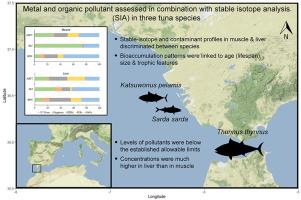当前位置:
X-MOL 学术
›
Mar. Environ. Res.
›
论文详情
Our official English website, www.x-mol.net, welcomes your feedback! (Note: you will need to create a separate account there.)
Assessment of metal and organic pollutants in combination with stable isotope analysis in tunas from the Gulf of Cadiz (east Atlantic)
Marine Environmental Research ( IF 3.3 ) Pub Date : 2024-03-03 , DOI: 10.1016/j.marenvres.2024.106432 Marina G. Pintado-Herrera , José A. López-López , Pablo A. Lara-Martín , Antonio Medina , Irene Cadenas , Sara Giansiracusa , Carmen Corada-Fernández , José L. Varela
Marine Environmental Research ( IF 3.3 ) Pub Date : 2024-03-03 , DOI: 10.1016/j.marenvres.2024.106432 Marina G. Pintado-Herrera , José A. López-López , Pablo A. Lara-Martín , Antonio Medina , Irene Cadenas , Sara Giansiracusa , Carmen Corada-Fernández , José L. Varela

|
Bioaccumulation patterns of heavy metals (Pb, Cd, Cr, Ni, Fe and Cu) and organic (priority and emerging) pollutants, in combination with stable isotope analysis (SIA), were assessed in muscle and liver of three tuna species from the Gulf of Cadiz (Atlantic bluefin tuna, ; Atlantic bonito, , and skipjack tuna, ). SIA and contaminant (heavy metal and organic) profiles separately discriminated between species. There was no significant overlap between the trophic niches estimated from isotopic data, suggesting that there are diet differences which may determine differential bioaccumulation patterns. The levels of heavy metals and persistent organic pollutants in muscle of all the individuals analyzed were below the allowable limits established by the current legislation. Concentrations of most contaminants were higher in liver than in muscle, underlining the powerful detoxifying capacity of the liver in tunas. In addition to diet, other factors such as size and age (exposure time to environmental chemicals) explain differences in pollutant accumulation patterns in tissues between species, each with varying degrees of involvement depending on the pollutant class. Our results show that combining contaminant profile data with trophic features based on SIA may help understand pollutant bioaccumulation patterns in upper levels of marine food webs.
中文翻译:

结合稳定同位素分析对加的斯湾(东大西洋)金枪鱼的金属和有机污染物进行评估
结合稳定同位素分析 (SIA),评估了来自海湾的三种金枪鱼的肌肉和肝脏中重金属(Pb、Cd、Cr、Ni、Fe 和 Cu)和有机(优先和新兴)污染物的生物累积模式加的斯(大西洋蓝鳍金枪鱼,;大西洋鲣鱼,和鲣鱼,)。 SIA 和污染物(重金属和有机)概况分别区分物种。根据同位素数据估计的营养位之间没有显着重叠,这表明饮食差异可能决定不同的生物累积模式。所有分析个体的肌肉中重金属和持久性有机污染物的含量均低于现行立法规定的允许限度。大多数污染物在肝脏中的浓度高于肌肉中的浓度,这突显了金枪鱼肝脏强大的解毒能力。除了饮食之外,其他因素,如体型和年龄(接触环境化学物质的时间)也解释了物种之间组织中污染物积累模式的差异,每个因素的参与程度取决于污染物类别。我们的结果表明,将污染物概况数据与基于 SIA 的营养特征相结合可能有助于了解海洋食物网上层的污染物生物累积模式。
更新日期:2024-03-03
中文翻译:

结合稳定同位素分析对加的斯湾(东大西洋)金枪鱼的金属和有机污染物进行评估
结合稳定同位素分析 (SIA),评估了来自海湾的三种金枪鱼的肌肉和肝脏中重金属(Pb、Cd、Cr、Ni、Fe 和 Cu)和有机(优先和新兴)污染物的生物累积模式加的斯(大西洋蓝鳍金枪鱼,;大西洋鲣鱼,和鲣鱼,)。 SIA 和污染物(重金属和有机)概况分别区分物种。根据同位素数据估计的营养位之间没有显着重叠,这表明饮食差异可能决定不同的生物累积模式。所有分析个体的肌肉中重金属和持久性有机污染物的含量均低于现行立法规定的允许限度。大多数污染物在肝脏中的浓度高于肌肉中的浓度,这突显了金枪鱼肝脏强大的解毒能力。除了饮食之外,其他因素,如体型和年龄(接触环境化学物质的时间)也解释了物种之间组织中污染物积累模式的差异,每个因素的参与程度取决于污染物类别。我们的结果表明,将污染物概况数据与基于 SIA 的营养特征相结合可能有助于了解海洋食物网上层的污染物生物累积模式。



























 京公网安备 11010802027423号
京公网安备 11010802027423号